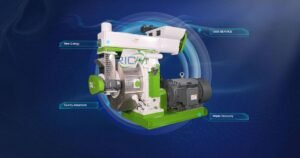Producing fertilizer from cow dung involves converting the raw manure into pellets that are easier to handle, transport, and apply to soil. Specialized fertilizer making machines are used to process cow dung into high-quality organic fertilizer pellets. Below is an overview of the key machinery used in this process:
1. Cow Dung Dehydration Machine
- Purpose: The raw cow dung typically has high moisture content, which needs to be reduced before further processing.
- Equipment: A solid-liquid separator or dewatering machine is used to remove excess moisture from the cow dung. This machine compresses the dung, separating the liquid from the solids.
- Output: The moisture content is typically reduced to around 30-40%, making the material suitable for the next stages of processing.
2. Composting Turner
- Purpose: To convert raw cow dung into compost, it needs to go through a composting process. This involves breaking down the organic matter in the cow dung through microbial activity.
- Equipment: A composting turner (either a groove-type or windrow turner) is used to aerate and mix the dung, promoting microbial activity and speeding up the composting process.
- Process Duration: Depending on the conditions, composting can take several weeks, after which the cow dung becomes nutrient-rich compost, ready for pelletizing.
3. Crushing Machine
- Purpose: After composting, the cow dung may still contain large clumps or lumps, which need to be crushed into fine particles.
- Equipment: A fertilizer crusher or pulverizer is used to break down the compost into smaller particles, ensuring uniformity and better pellet formation in the subsequent stages.
4. Mixing Machine
- Purpose: At this stage, additional nutrients (such as nitrogen, phosphorus, and potassium) or additives like binders may be mixed into the compost to enhance its nutritional value and improve pellet formation.
- Equipment: A horizontal mixer or vertical mixer is used to blend the compost with these additives, ensuring a homogeneous mix.
5. Pelletizing Machine
- Purpose: The composted and mixed cow dung is then processed into pellets using a pelletizing machine.
- Equipment:
- Flat Die Pellet Mill: This is commonly used for small to medium-scale production. The mixed material is forced through the die, forming cylindrical pellets.
- Ring die pellet machine: Used in large-scale fertilizer production, this machine shapes the material into pellets through rolling and granulation inside a rotating drum.
- Pellet Size: The size of the pellets can be adjusted depending on the die or granulator settings. Typical pellet sizes range from 3-10 mm in diameter.
6. Drying Machine
- Purpose: The pellets formed during the pelletizing process still contain some moisture, which needs to be reduced for proper storage and application.
- Equipment: A rotary drum dryer or fluid bed dryer is used to dry the pellets, reducing their moisture content to around 10-15%. This ensures the pellets are hard, stable, and have a long shelf life.
- Energy Efficiency: Modern drying systems are often equipped with energy recovery units to minimize fuel consumption.
7. Cooling Machine
- Purpose: After drying, the pellets are still hot and need to be cooled before packaging.
- Equipment: A counterflow cooler is commonly used to reduce the temperature of the pellets, improving their durability and preventing moisture buildup during storage.
8. Screening Machine
- Purpose: The screening machine ensures that only pellets of the desired size move forward to the packaging stage, while oversized or undersized pellets are separated and recycled back into the process.
- Equipment: A rotary screen or vibrating screen is used to separate fine particles and oversized lumps from the final product.
9. Packaging Machine
- Purpose: The finished pellets are then packaged for distribution and storage.
- Equipment: Automated packaging machines weigh and pack the cow dung pellets into bags or containers. Sealing and labeling machines are often part of the packaging system to ensure that the fertilizer is properly contained and labeled.
- Storage Considerations: The pellets should be packed in moisture-proof bags to prevent degradation and nutrient loss during storage.
Key Considerations:
- Raw Material Quality: The quality of cow dung, such as moisture content and consistency, directly affects the efficiency of the machines and the quality of the final pellets.
- Pellet Size and Durability: The pellet mill and drying process must be optimized to produce pellets that are durable and have the right nutrient balance.
- Energy Consumption: Energy-efficient machines (especially for drying and cooling) are critical to reducing operational costs in large-scale production.
- Automation: Many modern fertilizer plants use automated systems to monitor and control the various stages of production, increasing efficiency and reducing labor.
Conclusion
The production of cow dung fertilizer pellets involves multiple stages, including dewatering, composting, mixing, pelletizing, drying, and packaging. Each stage requires specific machinery designed to optimize the process, ensuring high-quality fertilizer pellets that are nutrient-rich, easy to store, and ready for agricultural use.
Feel free to ask for further details on any specific machinery or step!



